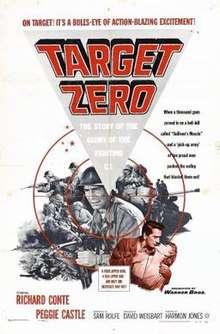Target Zero
Target Zero is a 1955 American drama film directed by Harmon Jones and written by James Warner Bellah and Sam Rolfe. The film stars Richard Conte, Peggie Castle, Charles Bronson, Richard Wyler, L. Q. Jones and Chuck Connors. The film was released by Warner Bros. on November 15, 1955.[1][2]
| Target Zero | |
|---|---|
 Theatrical release poster | |
| Directed by | Harmon Jones |
| Produced by | David Weisbart |
| Written by | James Warner Bellah Sam Rolfe |
| Starring | Richard Conte Peggie Castle Charles Bronson Richard Wyler L. Q. Jones Chuck Connors |
| Music by | David Buttolph |
| Cinematography | Edwin B. DuPar |
| Edited by | Clarence Kolster |
Production company | |
| Distributed by | Warner Bros. |
Release date |
|
Running time | 92 minutes |
| Country | United States |
| Language | English |
Plot
During a Korean War skirmish, a United Nations relief worker, Ann Galloway (Peggie Castle), is injured and her assistant killed. As the Communist forces take over the region, Ann accompanies a patrol led by Lt. Tom Flagler (Richard Conte), a soldier's soldier, admired by his men, as they try to rejoin Easy Company and other allied troops.
The British sergeant named Kensemmit (Richard Wyler) bears a grudge against all fellow soldiers and is particularly contemptuous of Flagler, as well as possibly interested in Ann romantically, though this latter point is never made clear and is left deliberately unclear. SFC Vince Gaspari (Charles Bronson) vouches for Tom completely as a born leader, although he acknowledges Ann's conclusion that Tom cares about nothing else than his military duty to be true. By contrast the other two British tank soldiers, Harry (pronounced "'arry" due to his working class accent) Fontenoy (Terence De Marney) and Cpt. Devon Enoch (John Alderson) both get along very well with the Americans, and in two scenes explicitly criticize Sgt. Kensemmit for his unnecessary hostile attitude. During one scene Pvt. Geronimo, a Native American soldier (played by Abel Fernandez) from the Apache reservation in Arizona says to a southern-accented white American soldier that Native Americans were in this war so that they could get practice fighting for the eventual day when they reconquer the United States. Pvt. Harry "'arry" Fontenoy (Terence de Marney) says to the southern-accented GI "Don't worry mate, if they chuck you out, we'll take you back!" to which the southern-accented GI says "Thanks ole buddy, but the problem with that is I don't speak the language!"
The patrol discovers that Easy Company has been massacred, leaving Tom discouraged. However, under orders to hold the region until help can arrive, Tom and his men fight off North Korean foes. In the course of this Lt. Tom Flagler (Richard Conte) and Sgt. Kensemmit (Richard Wyler) reconcile their differences, with Kensemmit (Richard Wyler) apologizing and saying that "I just woke up on the wrong side of the world this morning", to which Flagler (Richard Conte) replied, "No worries, you're a handy guy to have around" in reference to a previous scene in which Kensemmit's fighting abilities proved crucial to a victory against the communists. In victory, Flagler and Kensemmit both come to realize that Ann represents the very kind of thing they have been fighting for all along.
Cast
- Richard Conte as Lt. Tom Flagler
- Peggie Castle as Ann Galloway
- Charles Bronson as SFC Vince Gaspari
- Richard Wyler as Sgt. David Kensemmit
- L.Q. Jones as Pvt. Felix O'Hara
- Chuck Connors as Pvt. Moose
- John Alderson as Cpl. Devon Enoch
- Terence De Marney as Pvt. Harry Fontenoy
- Strother Martin as Pvt. Dan O'Hirons
- John Dennis as Pfc. George
- Angela Loo as Sue
Production
The F-80 Shooting Star aircraft were flown by the 120th Fighter Squadron of the Colorado Air National Guard.[3] The film was shot at Fort Carson, Colorado and in Arizona.[4]
Release
The film opened at the Paramount Theatre in New York City but only lasted 8 days with a gross of just $30,000.[5]
References
- "Target Zero (1955) - Overview". TCM.com. Retrieved 2015-05-30.
- Crowther, Bosley (1955-11-16). "Movie Review - Target Zero - Screen: 'Target Zero'; Korean Conflict Story Misses the Mark". NYTimes.com. Retrieved 2015-05-30.
- "Target Zero". 4 May 1956. Retrieved 22 June 2016 – via IMDb.
- "B'way Slips in Snow; 'Target' Light 30G in 8". Variety. November 23, 1955. p. 9. Retrieved April 24, 2019.
External links
- Target Zero on IMDb
- Target Zero at AllMovie
- Target Zero at the TCM Movie Database
- Target Zero at the American Film Institute Catalog